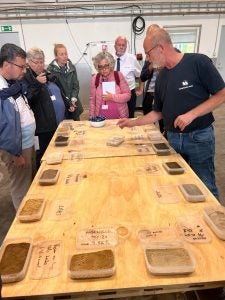I just got back from the International Federation of Agricultural Journalists congress in Denmark. This is an annual weeklong event where professional ag journalists from all around the world come together in a different country to learn all about farming in that area. For 2022, around 180 people attended from nearly 60 countries. It was my first time attending the full congress, and what an amazing opportunity for networking, education, and lifelong friendships full of likeminded people with the same goal in mind: agriculture communications.
This year we stayed in Vingsted, Denmark, but traveled across the country to see and learn about all different types of agriculture — from pig farms to plant breeding; dairy headquarters to aquaculture; biogas, sustainability and more! I found out about it through The Agricultural Communicators Network, which had long been known as the American Agricultural Editors Association. Perfect timing as their annual conference called the Ag Media Summit is going on now in Raleigh, and I’m so thankful for the opportunities they provide for ag media professionals!
Globally in agriculture, I notice similar trends. There’s a heavy focus on sustainability and reducing emissions, with similar shifts in consumer buying habits and farming transitions. In Denmark, the organic market has dropped 25 percent in eggs and 5 percent in fish as a premium product that people might “claim” they want but don’t actually want to pay for it.
Communication and correcting misperceptions in ag is also a focus; the importance of telling your story to not be in bad standing with the general public as they’re so far removed from the farm nowadays. It’s the whole common problem of “What do we need farmers for? Just buy food at the supermarket!” mentality. Education is everything! Labor, government regulations, financials and markets, activists, etc. all play a role in making the farmers job more difficult or complicated. Agritourism is also quite popular here, where people will pay to go on farm tours to get kids and adults alike excited about it.
My favorite part of the Denmark trip was the aquaculture tour, where they’ve found a way to suck up an invasive starfish species (that eat beneficial blue shellfish) into a type of organic fish meal “marine protein powder” for livestock so they can be less dependent on foreign imports. The Danish coop is called Vestjyllands andel and is owned by 4,000 farmers that make this protein throughout their season of November to April. (Proteins are made from grasses in the summer.)
As it stands, only 8 percent of soy is locally grown in the European Union, and they import 15 to 20 tons of soybeans per week for livestock feed, but Danish researchers are trying to breed plants to be higher in protein to be more self sufficient and sustainable overall and reduce or eliminate the need for global shipping. Denmark lost €3 million to €4 million when the pandemic hit and China couldn’t export organic protein to them, so being more self sufficient is certainly a goal they’ve tried to raise awareness on.
Another issue? Unfortunately for South America, soy from there generally has a bad reputation for deforestation.
Imagine a life with zero waste to use byproducts from everything? According to Vestjyllands andel partner GreenLabs, one company’s waste is another company’s resource and they focus on being a facilitator for green energy companies to come and work together. In addition to their thriving “surplus share” renewable energy and biogas/biochar sector, they’re turning cardboard fibers into countertops, grass into plates. They take byproducts from the sea, rapeseed, grass, starfish damage and waste from local fisheries and find new ways to use it. Even Mushrooms, grass, leftover food scraps, scales from fish, ground shrimp shells, invasive starfish and more are used for pig & poultry which good for their bones! (And doesn’t compromise meat quality or flavor.) GreenLabs considers themselves mission driven Visionaries and claim to be fortunate to be in the Skive municipality that’s really focused on green agriculture.

Another part of the trip that I found interesting was the fact that there are so many similarities between Danish and U.S. agriculture. Coming from an Iowa farming background, I noticed a lot of the farms in Denmark looked, felt, and smelled (haha!) the same! From the equipment, grain bins, fields, livestock breeds and more, it’s nice to see the same focuses on things like sustainability, production, and a better environmental footprint.
The biggest difference was some of the architecture — beautifully fascinating to see barns made out of stone from the 1800s.
Overall, trips like this just inspire me. Inspires me to do more — to give back and be more involved with these incredible organizations. We all must work together around the globe to strengthen agriculture and our industry sure does have a beautiful story to tell. I understand why people attend these events, year after year and cannot say good enough things about this experience with memories that last a lifetime. I look forward to attending more in the future.
Michelle Miller, the Farm Babe, is a farmer, public speaker and writer who has worked for years with row crops, beef cattle, and sheep. She believes education is key in bridging the gap between farmers and consumers.



